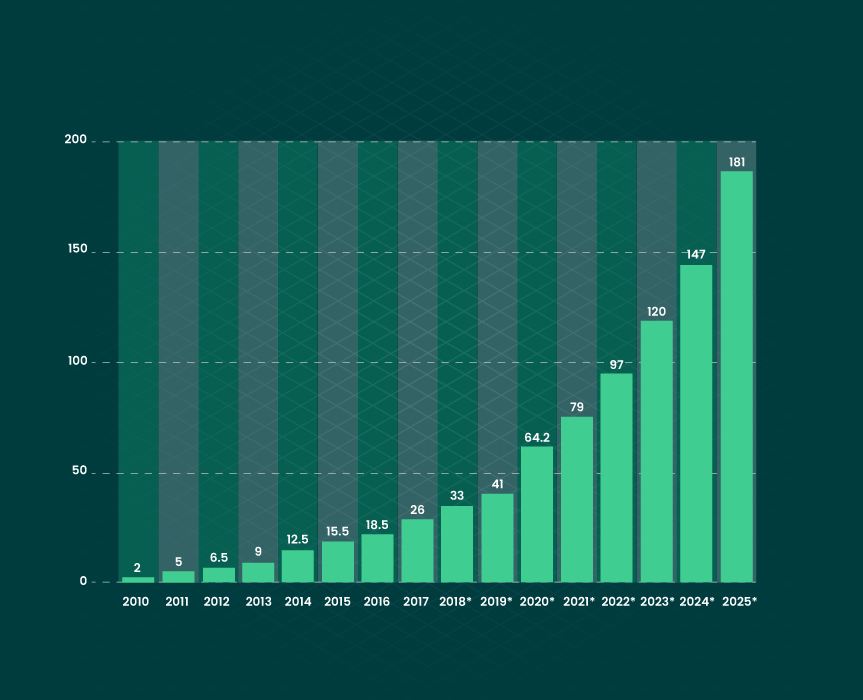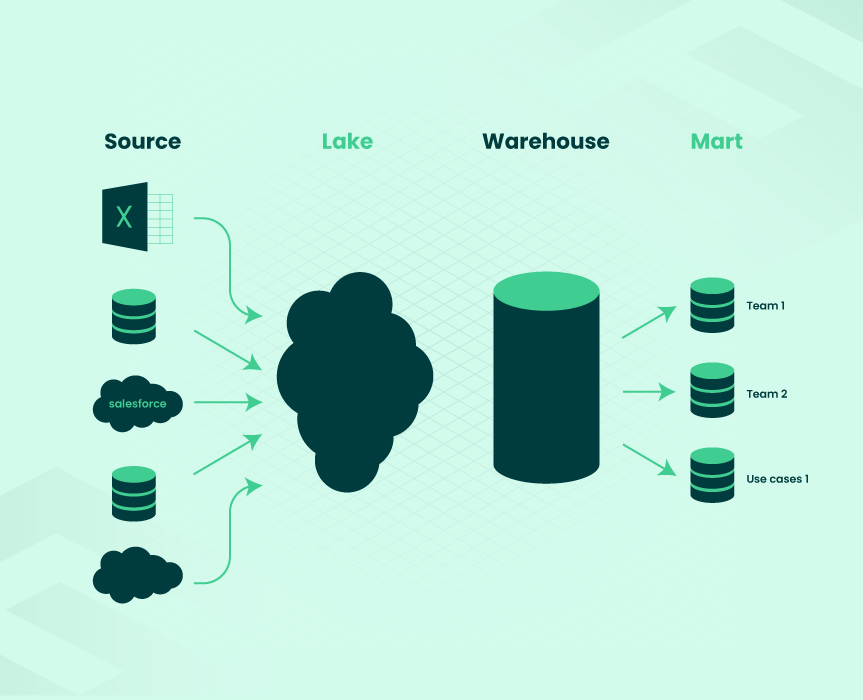A big challenge for businesses nowadays is data. You may wonder how data can be a challenge if it is a weapon for strategic business opportunities? Indeed. Let us be more precise.
In the past, businesses made decisions based on previous experience; today, their decisions are data-driven. To make the most out of huge amounts of data, companies need to handle it properly to be able to identify insights and build intelligent strategies to ensure their competitive edge.
To enhance better decision-making, it is important to collect data from various sources, integrate it, and analyze it in a way it will contribute to your business intelligence. Let’s figure out what BI stands for, why it is important, and how to develop your business intelligence strategy.
What Is Business Intelligence: History, Development, Definition
History
Let us start with history.
The “business intelligence” term was first used in 1865 by Millar Devens
in the Cyclopædia of Commercial and Business Anecdotes. He described how Sir Henry Furnese, a banker, gained benefits from data collecting and analysis to stay ahead of the competition. Then, in 1958, an IBM computer scientist named Hans Peter Luhn published an essay called “Business Intelligence System,” where he described the concept of BI powered by technology (as it is understood today).
The next seeds were planted to manage and integrate data into a centralized database. Addressing the problem of data storing in siloes, Edgar Codd proposed the model of “relational database management systems ” in his paper in 1970.
The 1970s and 1980s were the years of instant development of BI systems and the birth of the first data warehouses. In the 2000s, IBM, Microsoft, and Oracle contributed to BI 2.0 acceleration. Now, we are in the 3.0 stage of business intelligence.
Definition
Business intelligence (BI) consists of strategies and technologies to collect raw data, analyze it, and turn it into comprehensive insights that drive effective business decisions. It includes data mining, forecasting, analysis, reporting, etc.
To measure performance and figure out how you will manage your data and make data-driven decisions, you need a blueprint/roadmap/strategy. Actually, we are here to provide you with all the necessary information to develop a well-defined BI strategy.
Why Do You Need BI Strategy: Benefits for Your Business
The global BI market is anticipated to grow from $23,1 billion in 2020 to $33,3 billion in 2025, as per the MarketandMarkets report. The figures tell us that adoption of BI applications is accelerated worldwide. Without a proper business intelligence strategy, there is a low chance of successfully implementing the business intelligence project.
To figure out why BI strategy is essential to your company’s success, it will be reasonable to explain what happens when you do not have a well-defined business intelligence strategy. With abundant data from different systems and sources, companies face data overload that needs to be structured and comprehended to bring value and outcomes. What’s interesting, the volume of data created and consumed globally is rapidly growing, and over the next five years from 2020, it is anticipated to increase by almost three times, reaching 181 zettabytes.
 business intelligence impact (2010-2025)
business intelligence impact (2010-2025)
Otherwise, the data that “is not over control” loses its quality and integrity, leading to data-related problems that need to be addressed. To prevent this, the BI strategy comes in. It helps extract comprehensive insights from raw data and translate them into strategic planning.
BI strategy depends on the company’s goals. Maybe, you want to improve employee productivity or gain insights into your customers’ behavior. Determining your goal will help you accurately develop your business intelligence strategy.
With BI strategy, you will be able to:
- Early identify issues by monitoring KPIs
- Drive fast and effective decision-making
- Precisely assess business requirements and market demand
- Determine all possible ways of data usage
- Evaluate development risks
- Improve operational efficiency
- Aggregate different data sources into a unified system
- Enhance marketing and sales programs via competitive analysis
- Raise revenue thanks to increased customer satisfaction
Business intelligence tools can be embedded into business applications and systems such as CRM and ERP to support data analysis within one workspace without the need to switch between separate tools. Therefore, various industries have been reaping the operational benefits of the BI strategy.
How to Develop a BI Strategy
As mentioned above, your business intelligence strategy needs to be aligned with your business goals. We outlined the steps you should follow to make your BI strategy more effective.
1. Create a BI vision
To create a concise vision of your BI strategy, you first need to define your current state. Once you know where you are now, you will be able to define what is possible to achieve. First, you need to analyze where you are now by connecting data from different sources.
Then, set up your objectives and priorities, which will help you understand how BI can contribute to your business performance. Afterward, you will be on the path toward establishing clear and realistic expectations. At this stage, it is important to determine the following:
- What data will be collected?
- Who will be involved in BI processes?
- How will BI strategy be integrated with the corporate business operations?
- How to deliver BI solutions?
- What BI tool to select?
- Which KPIs do you need to monitor?
- What will BI lifecycle management look like?
2. Assemble a BI team
The business intelligence team is responsible for data discovery, analyzing, and connecting it with end-users. For large organizations, there are a variety of BI roles and responsibilities. However, they can be combined and narrowed to one position if you have a limited budget for human resources. If you are planning to create your in-house team, consider the following main roles:
- BI project manager – bridges the gaps between business and technology stakeholders.
- BI architect – established BI infrastructure by translating business requirements into the data warehouse.
- BI analyst – a person who is responsible for data mining and analysis to achieve meaningful insights.
- ETL developer – manages ETL processes for the data warehouse.
- Data visualization analyst – a person who delivers informative clean visuals from the analyzed data to end-users.
- System administrator – installs and monitors the hardware.
If you need an outsourcing BI team, our company can help you with a dedicated team structure aligned to your specific needs.
3. Establish your BI architecture
There are different architectural approaches available depending on required configurations. According to Chartio’s eBook Cloud Data Management, there are four stages of data sophistication:
- Source data (siloed data from datasets like Excel spreadsheets, Salesforce, Hubspot, etc.)
- Data lake (a single repository for storing unstructured data from data sources. Data in the lake is unstructured and is not ready for analysis).
- Data warehouse (it is a single source of truth where data is structured, cleaned, and ready for consumption).
- Datamart (it is a data set designed for specific use cases).
In the picture below, you can see a pipeline from where data 1) is extracted, then 2) it is loaded to the lake or 3) warehouse, and finally, 4) it is categorized into marts to be used explicitly by different departments (HR, PM, Sales, Marketing, etc.). The ultimate data flow destination is the end-user interface represented via reporting tools and interactive dashboards.
Different architectural approaches have specific capabilities. Depending on the growing organizational needs within your company, you can select one-tier, two-tier, and three-tier architecture:
- One-tier architecture is designed without domain-specific data mart layers (see above).
- The two-tier architecture is focused on adding data mart levels between the data warehouse and the user interface.
- The three-tier architecture allows multidimensional data analysis with the help of OLAP cubes (online analytical processing) which means that data is represented from multiple dimensions. To put it simply, data is divided hierarchically into categories and subcategories.
To learn more about OLAP cubes, check out our blog post about the benefits of BI in the retail industry.
Therefore, at this stage, you need to define your data sources that need to be integrated, define the type and architecture of the data warehouse (whether your business needs additional data mart layers, OLAP).

4. Choose the best software vendor for your business needs
We compiled several questions you need to ask your potential BI provider to evaluate their capabilities:
- Can the software/tool be integrated with your company’s existing systems?
- What deployment options does the solution offer: on-premises or cloud?
- Are there flexible user permissions for data fields?
- Is the software easy to use and navigate?
- Do your business requirements correspond to the software you select?
- Is the software scalable enough if your company’s demands will grow?
- Are the dashboards customizable?
- Does a vendor offer training to all the users, not only the tech team?
Of course, there are additional criteria you might want to assess before the selection. There are top players on the market that provide a wide range of functionalities in their BI tools such as Oracle, Tableau, IBM, Looker. However, you have to assess your specific business requirements. The thing is that ready-made solutions may be limited in solving your unique problems while at the same time offering features that can be excessive to your type of business and which you likely do not use at all. Yeah, ready-made solutions can be quickly and easily installed; however, when you are looking for the solution to adapt to changes and scaling needs of your business, custom software development can be your win-win option.
But what about costs? Initially, ready-made BI tools can be cheaper than investing in custom BI software, but they can cost you much more in the long run due to the permanent subscription costs and maintenance. Moreover, the price for subscriptions from ready-made vendors can grow depending on the number of users involved.
5. Select BI platform and environment
There are such deployment options available: on-premise, cloud, hybrid. To define which options will best suit your business goal, let’s compare them.
- On-premise is a model where infrastructure is installed locally so that it is under your total control. So, if you have a particular use case and are concerned about high privacy and security – this type can be perfect for you.
- The cloud environment is a model where data processing and management are performed by third-party providers in the cloud which eliminates the expenditures on the hardware and infrastructure purchases. Data security threats are the main ones constraining businesses from adopting cloud computing.
- Hybrid cloud connects on-premises data centers and public clouds that are integrated. This solution suits best businesses that want to store their critical workloads on on-premises (much more secure) and less-sensitive resources on a cloud provider.
Cloud environment requires selecting the platform to deploy your business intelligence roadmap. The leaders are Microsoft Azure, AWS, Google Cloud, IBM Bleumix.
6. Build a BI roadmap
A business intelligence roadmap is a visual document representing planned activities by dates, KPIs, deliverables, and milestones within the timeline. The roadmap should contain technical details and be attractive to end-users as well.
Must-Have Functions in Business Intelligence Software
- Data integration. InTostablish a solid data warehouse, BI software has to be designed with seamless data delivery and integration.
- Ad hoc analytics. This function is used for analyzing and answering a specific question. In contrast to traditional BI reporting, the ad-hoc analysis provides immediate and in-depth details about particular business processes and short-term decisions.
- Predictive analytics. Descriptive analytics is a traditional approach toward decision-making where historical data is analyzed. With predictive analytics, data scientists can forecast future events.
- BI dashboards. They are advanced reporting tools to display key business metrics via in-built intuitive data visualization.

Conclusion
If you want to make the most out of your data, you need to be ready for the progressive future of retail. Apply a business intelligence strategy to foster effective, fast decision-making and increase revenue. The selection of appropriate technology and software platforms is only a part of BI. If you want to increase your ROI and reap all the benefits from the valuable insights it provides you, follow the step-by-step BI strategy mentioned above.
Of course, each business has its specific needs; therefore, the strategy can be adjusted appropriately. With the right expert team, you will be able to achieve tangible results. Let us know if you need a consultation – our tech talent marketplace helps companies across industries create solid solutions. Contact us to learn more.

Our Engineers
Can Help
Are you ready to discover all benefits of running a business in the digital era?

Our Engineers
Can Help
Are you ready to discover all benefits of running a business in the digital era?







